Auditing and Assurance in Australia
VerifiedAdded on 2022/11/30
|10
|3374
|484
AI Summary
This article discusses the key assertions, substantive procedures, and importance of key audit matters in the context of two case studies in auditing and assurance in Australia.
Contribute Materials
Your contribution can guide someone’s learning journey. Share your
documents today.
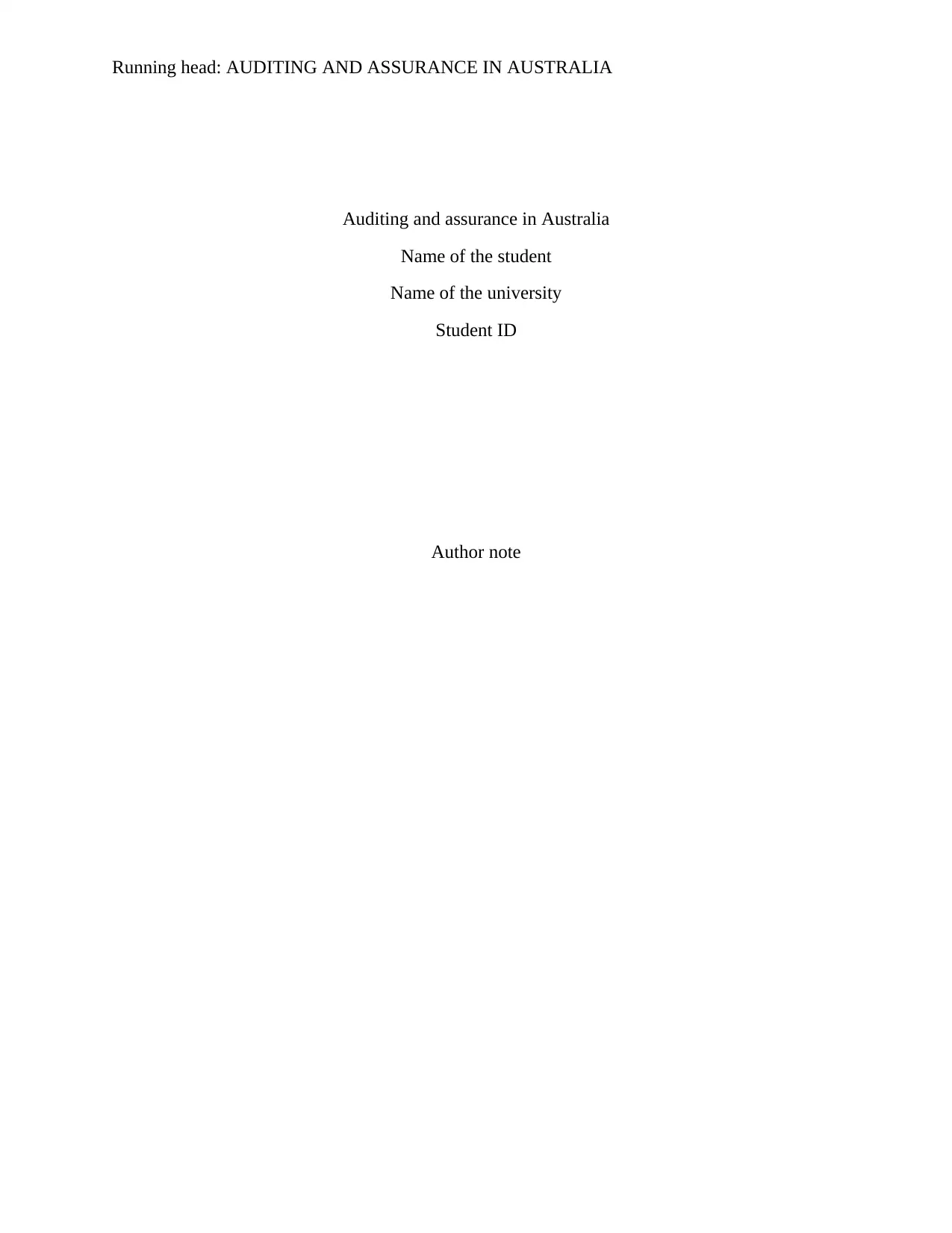
Running head: AUDITING AND ASSURANCE IN AUSTRALIA
Auditing and assurance in Australia
Name of the student
Name of the university
Student ID
Author note
Auditing and assurance in Australia
Name of the student
Name of the university
Student ID
Author note
Secure Best Marks with AI Grader
Need help grading? Try our AI Grader for instant feedback on your assignments.
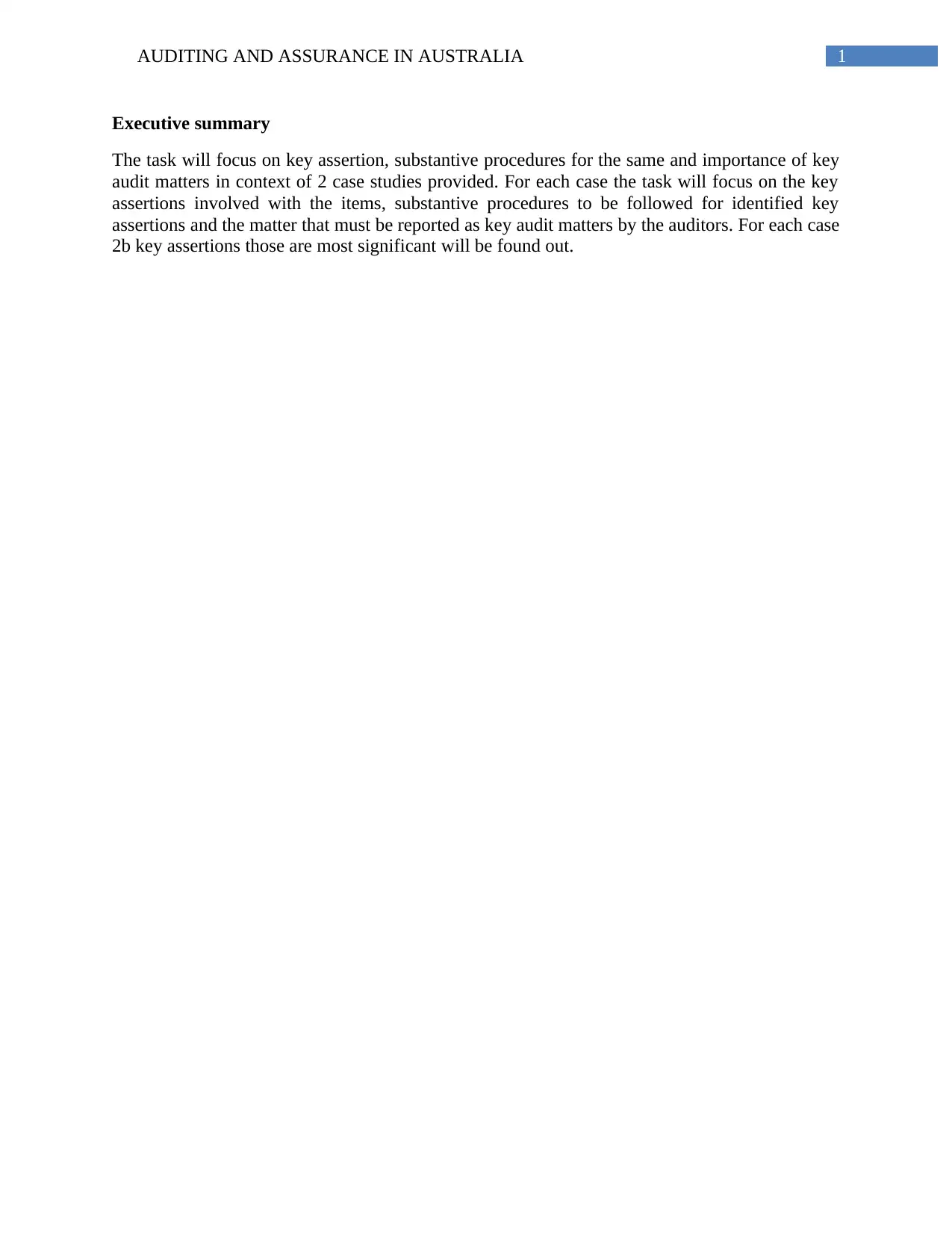
1AUDITING AND ASSURANCE IN AUSTRALIA
Executive summary
The task will focus on key assertion, substantive procedures for the same and importance of key
audit matters in context of 2 case studies provided. For each case the task will focus on the key
assertions involved with the items, substantive procedures to be followed for identified key
assertions and the matter that must be reported as key audit matters by the auditors. For each case
2b key assertions those are most significant will be found out.
Executive summary
The task will focus on key assertion, substantive procedures for the same and importance of key
audit matters in context of 2 case studies provided. For each case the task will focus on the key
assertions involved with the items, substantive procedures to be followed for identified key
assertions and the matter that must be reported as key audit matters by the auditors. For each case
2b key assertions those are most significant will be found out.
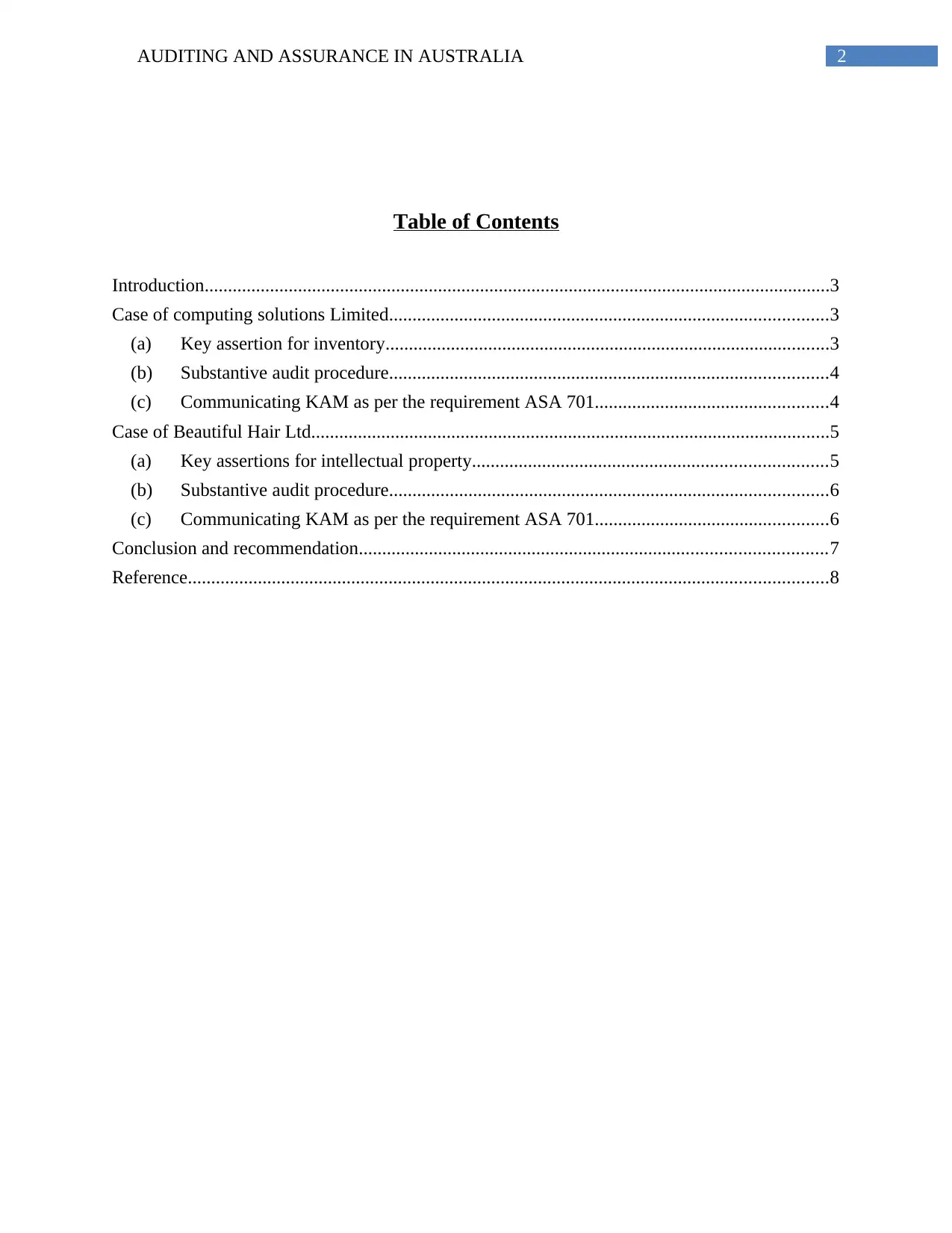
2AUDITING AND ASSURANCE IN AUSTRALIA
Table of Contents
Introduction......................................................................................................................................3
Case of computing solutions Limited..............................................................................................3
(a) Key assertion for inventory...............................................................................................3
(b) Substantive audit procedure..............................................................................................4
(c) Communicating KAM as per the requirement ASA 701..................................................4
Case of Beautiful Hair Ltd...............................................................................................................5
(a) Key assertions for intellectual property............................................................................5
(b) Substantive audit procedure..............................................................................................6
(c) Communicating KAM as per the requirement ASA 701..................................................6
Conclusion and recommendation....................................................................................................7
Reference.........................................................................................................................................8
Table of Contents
Introduction......................................................................................................................................3
Case of computing solutions Limited..............................................................................................3
(a) Key assertion for inventory...............................................................................................3
(b) Substantive audit procedure..............................................................................................4
(c) Communicating KAM as per the requirement ASA 701..................................................4
Case of Beautiful Hair Ltd...............................................................................................................5
(a) Key assertions for intellectual property............................................................................5
(b) Substantive audit procedure..............................................................................................6
(c) Communicating KAM as per the requirement ASA 701..................................................6
Conclusion and recommendation....................................................................................................7
Reference.........................................................................................................................................8
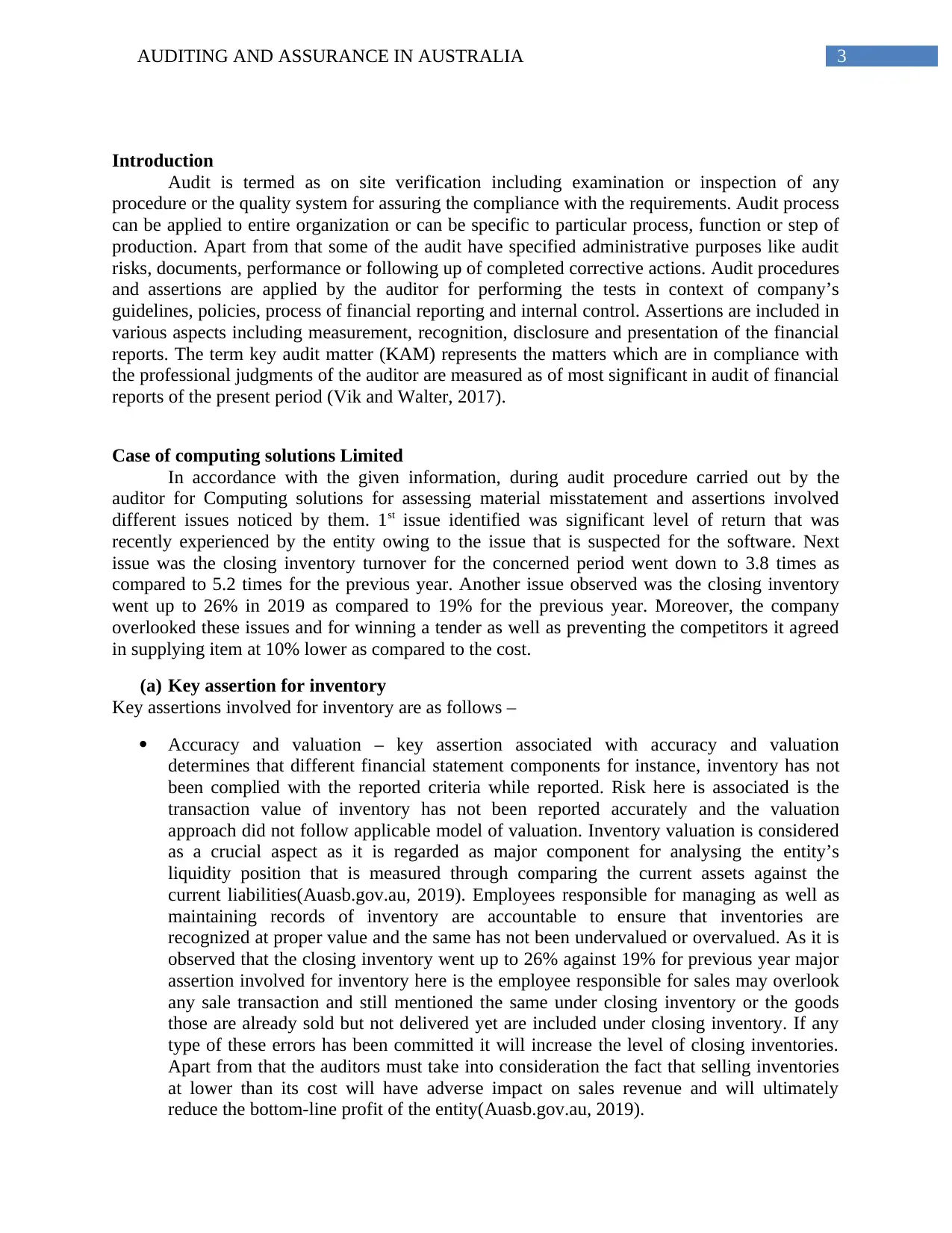
3AUDITING AND ASSURANCE IN AUSTRALIA
Introduction
Audit is termed as on site verification including examination or inspection of any
procedure or the quality system for assuring the compliance with the requirements. Audit process
can be applied to entire organization or can be specific to particular process, function or step of
production. Apart from that some of the audit have specified administrative purposes like audit
risks, documents, performance or following up of completed corrective actions. Audit procedures
and assertions are applied by the auditor for performing the tests in context of company’s
guidelines, policies, process of financial reporting and internal control. Assertions are included in
various aspects including measurement, recognition, disclosure and presentation of the financial
reports. The term key audit matter (KAM) represents the matters which are in compliance with
the professional judgments of the auditor are measured as of most significant in audit of financial
reports of the present period (Vik and Walter, 2017).
Case of computing solutions Limited
In accordance with the given information, during audit procedure carried out by the
auditor for Computing solutions for assessing material misstatement and assertions involved
different issues noticed by them. 1st issue identified was significant level of return that was
recently experienced by the entity owing to the issue that is suspected for the software. Next
issue was the closing inventory turnover for the concerned period went down to 3.8 times as
compared to 5.2 times for the previous year. Another issue observed was the closing inventory
went up to 26% in 2019 as compared to 19% for the previous year. Moreover, the company
overlooked these issues and for winning a tender as well as preventing the competitors it agreed
in supplying item at 10% lower as compared to the cost.
(a) Key assertion for inventory
Key assertions involved for inventory are as follows –
Accuracy and valuation – key assertion associated with accuracy and valuation
determines that different financial statement components for instance, inventory has not
been complied with the reported criteria while reported. Risk here is associated is the
transaction value of inventory has not been reported accurately and the valuation
approach did not follow applicable model of valuation. Inventory valuation is considered
as a crucial aspect as it is regarded as major component for analysing the entity’s
liquidity position that is measured through comparing the current assets against the
current liabilities(Auasb.gov.au, 2019). Employees responsible for managing as well as
maintaining records of inventory are accountable to ensure that inventories are
recognized at proper value and the same has not been undervalued or overvalued. As it is
observed that the closing inventory went up to 26% against 19% for previous year major
assertion involved for inventory here is the employee responsible for sales may overlook
any sale transaction and still mentioned the same under closing inventory or the goods
those are already sold but not delivered yet are included under closing inventory. If any
type of these errors has been committed it will increase the level of closing inventories.
Apart from that the auditors must take into consideration the fact that selling inventories
at lower than its cost will have adverse impact on sales revenue and will ultimately
reduce the bottom-line profit of the entity(Auasb.gov.au, 2019).
Introduction
Audit is termed as on site verification including examination or inspection of any
procedure or the quality system for assuring the compliance with the requirements. Audit process
can be applied to entire organization or can be specific to particular process, function or step of
production. Apart from that some of the audit have specified administrative purposes like audit
risks, documents, performance or following up of completed corrective actions. Audit procedures
and assertions are applied by the auditor for performing the tests in context of company’s
guidelines, policies, process of financial reporting and internal control. Assertions are included in
various aspects including measurement, recognition, disclosure and presentation of the financial
reports. The term key audit matter (KAM) represents the matters which are in compliance with
the professional judgments of the auditor are measured as of most significant in audit of financial
reports of the present period (Vik and Walter, 2017).
Case of computing solutions Limited
In accordance with the given information, during audit procedure carried out by the
auditor for Computing solutions for assessing material misstatement and assertions involved
different issues noticed by them. 1st issue identified was significant level of return that was
recently experienced by the entity owing to the issue that is suspected for the software. Next
issue was the closing inventory turnover for the concerned period went down to 3.8 times as
compared to 5.2 times for the previous year. Another issue observed was the closing inventory
went up to 26% in 2019 as compared to 19% for the previous year. Moreover, the company
overlooked these issues and for winning a tender as well as preventing the competitors it agreed
in supplying item at 10% lower as compared to the cost.
(a) Key assertion for inventory
Key assertions involved for inventory are as follows –
Accuracy and valuation – key assertion associated with accuracy and valuation
determines that different financial statement components for instance, inventory has not
been complied with the reported criteria while reported. Risk here is associated is the
transaction value of inventory has not been reported accurately and the valuation
approach did not follow applicable model of valuation. Inventory valuation is considered
as a crucial aspect as it is regarded as major component for analysing the entity’s
liquidity position that is measured through comparing the current assets against the
current liabilities(Auasb.gov.au, 2019). Employees responsible for managing as well as
maintaining records of inventory are accountable to ensure that inventories are
recognized at proper value and the same has not been undervalued or overvalued. As it is
observed that the closing inventory went up to 26% against 19% for previous year major
assertion involved for inventory here is the employee responsible for sales may overlook
any sale transaction and still mentioned the same under closing inventory or the goods
those are already sold but not delivered yet are included under closing inventory. If any
type of these errors has been committed it will increase the level of closing inventories.
Apart from that the auditors must take into consideration the fact that selling inventories
at lower than its cost will have adverse impact on sales revenue and will ultimately
reduce the bottom-line profit of the entity(Auasb.gov.au, 2019).
Secure Best Marks with AI Grader
Need help grading? Try our AI Grader for instant feedback on your assignments.
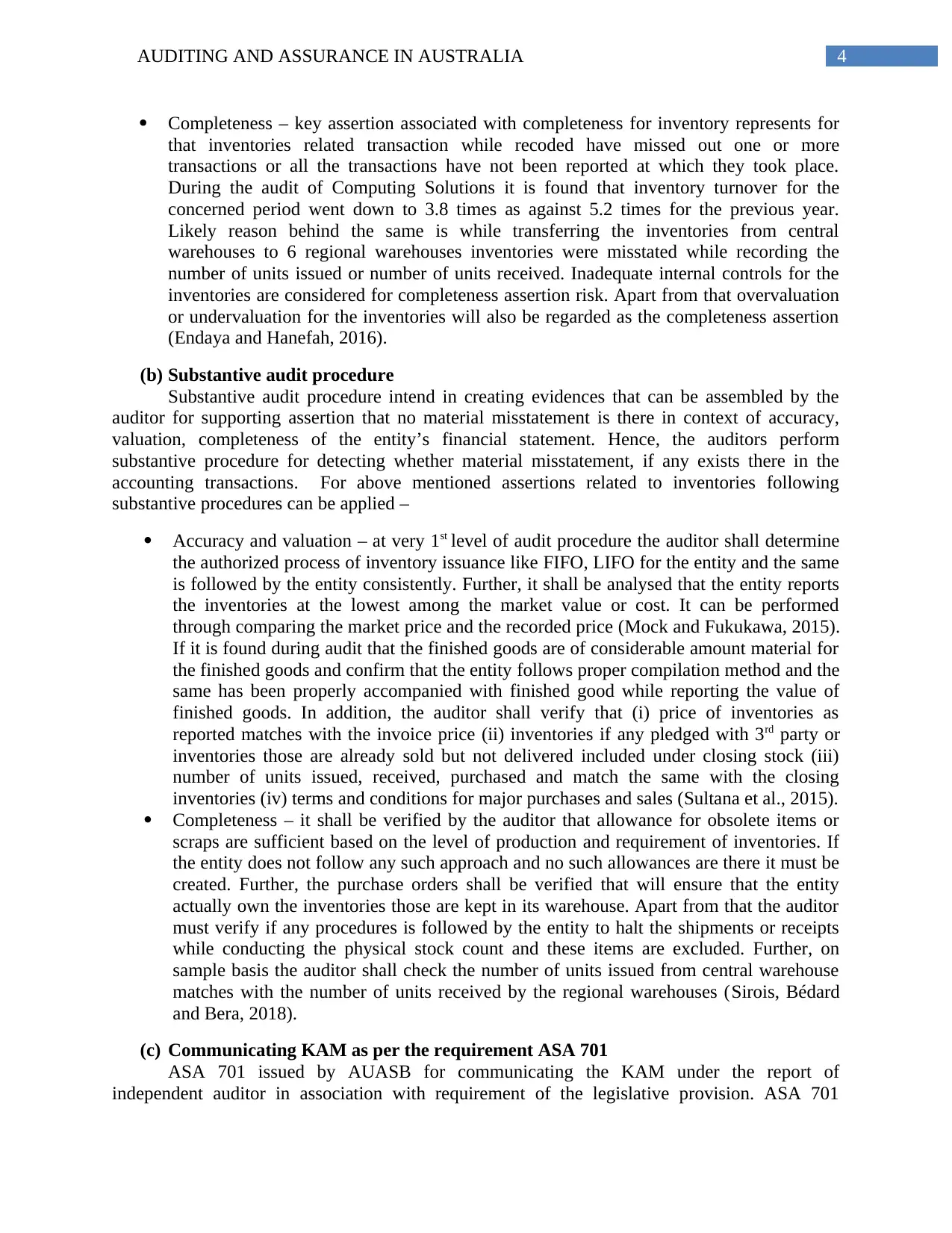
4AUDITING AND ASSURANCE IN AUSTRALIA
Completeness – key assertion associated with completeness for inventory represents for
that inventories related transaction while recoded have missed out one or more
transactions or all the transactions have not been reported at which they took place.
During the audit of Computing Solutions it is found that inventory turnover for the
concerned period went down to 3.8 times as against 5.2 times for the previous year.
Likely reason behind the same is while transferring the inventories from central
warehouses to 6 regional warehouses inventories were misstated while recording the
number of units issued or number of units received. Inadequate internal controls for the
inventories are considered for completeness assertion risk. Apart from that overvaluation
or undervaluation for the inventories will also be regarded as the completeness assertion
(Endaya and Hanefah, 2016).
(b) Substantive audit procedure
Substantive audit procedure intend in creating evidences that can be assembled by the
auditor for supporting assertion that no material misstatement is there in context of accuracy,
valuation, completeness of the entity’s financial statement. Hence, the auditors perform
substantive procedure for detecting whether material misstatement, if any exists there in the
accounting transactions. For above mentioned assertions related to inventories following
substantive procedures can be applied –
Accuracy and valuation – at very 1st level of audit procedure the auditor shall determine
the authorized process of inventory issuance like FIFO, LIFO for the entity and the same
is followed by the entity consistently. Further, it shall be analysed that the entity reports
the inventories at the lowest among the market value or cost. It can be performed
through comparing the market price and the recorded price (Mock and Fukukawa, 2015).
If it is found during audit that the finished goods are of considerable amount material for
the finished goods and confirm that the entity follows proper compilation method and the
same has been properly accompanied with finished good while reporting the value of
finished goods. In addition, the auditor shall verify that (i) price of inventories as
reported matches with the invoice price (ii) inventories if any pledged with 3rd party or
inventories those are already sold but not delivered included under closing stock (iii)
number of units issued, received, purchased and match the same with the closing
inventories (iv) terms and conditions for major purchases and sales (Sultana et al., 2015).
Completeness – it shall be verified by the auditor that allowance for obsolete items or
scraps are sufficient based on the level of production and requirement of inventories. If
the entity does not follow any such approach and no such allowances are there it must be
created. Further, the purchase orders shall be verified that will ensure that the entity
actually own the inventories those are kept in its warehouse. Apart from that the auditor
must verify if any procedures is followed by the entity to halt the shipments or receipts
while conducting the physical stock count and these items are excluded. Further, on
sample basis the auditor shall check the number of units issued from central warehouse
matches with the number of units received by the regional warehouses (Sirois, Bédard
and Bera, 2018).
(c) Communicating KAM as per the requirement ASA 701
ASA 701 issued by AUASB for communicating the KAM under the report of
independent auditor in association with requirement of the legislative provision. ASA 701
Completeness – key assertion associated with completeness for inventory represents for
that inventories related transaction while recoded have missed out one or more
transactions or all the transactions have not been reported at which they took place.
During the audit of Computing Solutions it is found that inventory turnover for the
concerned period went down to 3.8 times as against 5.2 times for the previous year.
Likely reason behind the same is while transferring the inventories from central
warehouses to 6 regional warehouses inventories were misstated while recording the
number of units issued or number of units received. Inadequate internal controls for the
inventories are considered for completeness assertion risk. Apart from that overvaluation
or undervaluation for the inventories will also be regarded as the completeness assertion
(Endaya and Hanefah, 2016).
(b) Substantive audit procedure
Substantive audit procedure intend in creating evidences that can be assembled by the
auditor for supporting assertion that no material misstatement is there in context of accuracy,
valuation, completeness of the entity’s financial statement. Hence, the auditors perform
substantive procedure for detecting whether material misstatement, if any exists there in the
accounting transactions. For above mentioned assertions related to inventories following
substantive procedures can be applied –
Accuracy and valuation – at very 1st level of audit procedure the auditor shall determine
the authorized process of inventory issuance like FIFO, LIFO for the entity and the same
is followed by the entity consistently. Further, it shall be analysed that the entity reports
the inventories at the lowest among the market value or cost. It can be performed
through comparing the market price and the recorded price (Mock and Fukukawa, 2015).
If it is found during audit that the finished goods are of considerable amount material for
the finished goods and confirm that the entity follows proper compilation method and the
same has been properly accompanied with finished good while reporting the value of
finished goods. In addition, the auditor shall verify that (i) price of inventories as
reported matches with the invoice price (ii) inventories if any pledged with 3rd party or
inventories those are already sold but not delivered included under closing stock (iii)
number of units issued, received, purchased and match the same with the closing
inventories (iv) terms and conditions for major purchases and sales (Sultana et al., 2015).
Completeness – it shall be verified by the auditor that allowance for obsolete items or
scraps are sufficient based on the level of production and requirement of inventories. If
the entity does not follow any such approach and no such allowances are there it must be
created. Further, the purchase orders shall be verified that will ensure that the entity
actually own the inventories those are kept in its warehouse. Apart from that the auditor
must verify if any procedures is followed by the entity to halt the shipments or receipts
while conducting the physical stock count and these items are excluded. Further, on
sample basis the auditor shall check the number of units issued from central warehouse
matches with the number of units received by the regional warehouses (Sirois, Bédard
and Bera, 2018).
(c) Communicating KAM as per the requirement ASA 701
ASA 701 issued by AUASB for communicating the KAM under the report of
independent auditor in association with requirement of the legislative provision. ASA 701
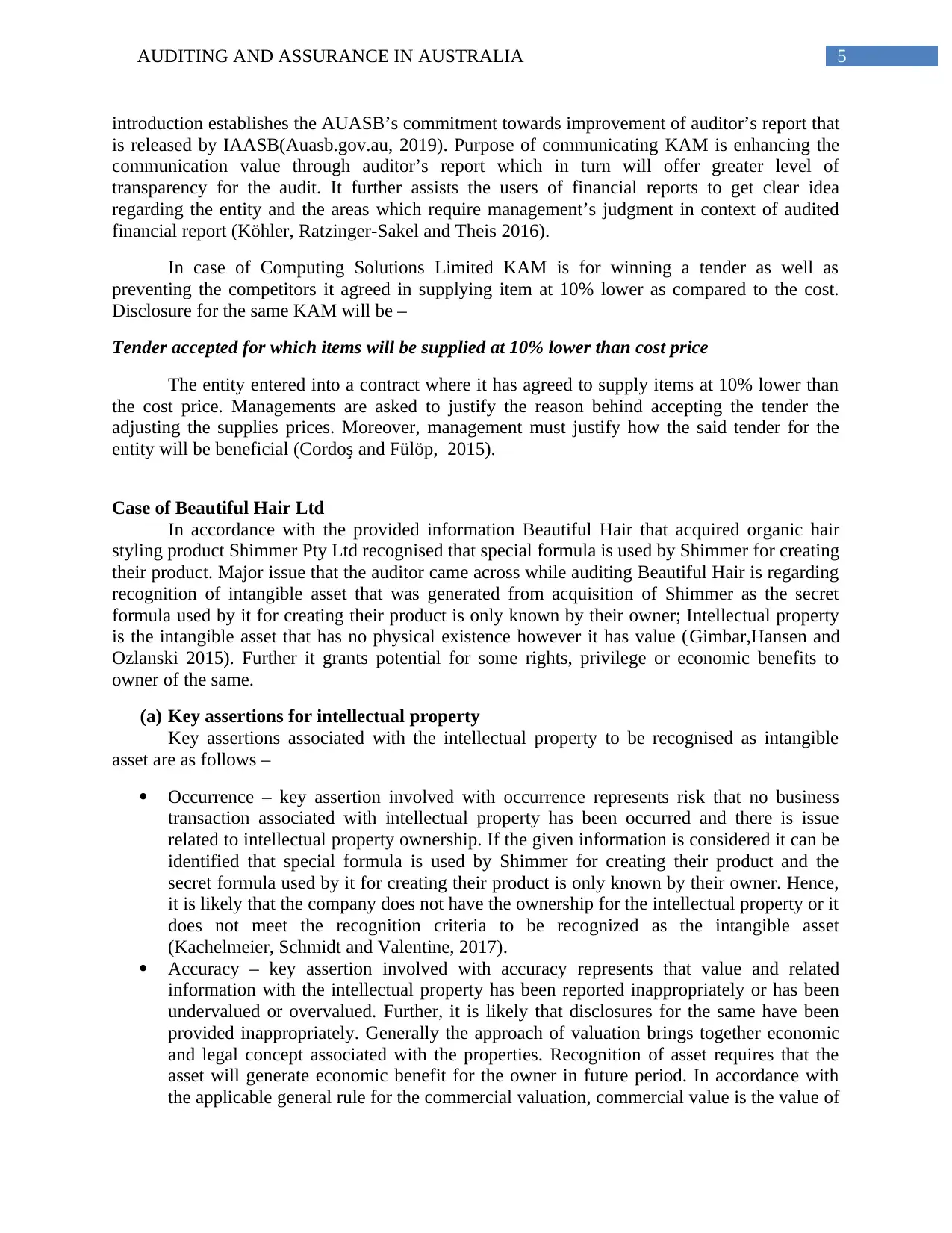
5AUDITING AND ASSURANCE IN AUSTRALIA
introduction establishes the AUASB’s commitment towards improvement of auditor’s report that
is released by IAASB(Auasb.gov.au, 2019). Purpose of communicating KAM is enhancing the
communication value through auditor’s report which in turn will offer greater level of
transparency for the audit. It further assists the users of financial reports to get clear idea
regarding the entity and the areas which require management’s judgment in context of audited
financial report (Köhler, Ratzinger-Sakel and Theis 2016).
In case of Computing Solutions Limited KAM is for winning a tender as well as
preventing the competitors it agreed in supplying item at 10% lower as compared to the cost.
Disclosure for the same KAM will be –
Tender accepted for which items will be supplied at 10% lower than cost price
The entity entered into a contract where it has agreed to supply items at 10% lower than
the cost price. Managements are asked to justify the reason behind accepting the tender the
adjusting the supplies prices. Moreover, management must justify how the said tender for the
entity will be beneficial (Cordoş and Fülöp, 2015).
Case of Beautiful Hair Ltd
In accordance with the provided information Beautiful Hair that acquired organic hair
styling product Shimmer Pty Ltd recognised that special formula is used by Shimmer for creating
their product. Major issue that the auditor came across while auditing Beautiful Hair is regarding
recognition of intangible asset that was generated from acquisition of Shimmer as the secret
formula used by it for creating their product is only known by their owner; Intellectual property
is the intangible asset that has no physical existence however it has value (Gimbar,Hansen and
Ozlanski 2015). Further it grants potential for some rights, privilege or economic benefits to
owner of the same.
(a) Key assertions for intellectual property
Key assertions associated with the intellectual property to be recognised as intangible
asset are as follows –
Occurrence – key assertion involved with occurrence represents risk that no business
transaction associated with intellectual property has been occurred and there is issue
related to intellectual property ownership. If the given information is considered it can be
identified that special formula is used by Shimmer for creating their product and the
secret formula used by it for creating their product is only known by their owner. Hence,
it is likely that the company does not have the ownership for the intellectual property or it
does not meet the recognition criteria to be recognized as the intangible asset
(Kachelmeier, Schmidt and Valentine, 2017).
Accuracy – key assertion involved with accuracy represents that value and related
information with the intellectual property has been reported inappropriately or has been
undervalued or overvalued. Further, it is likely that disclosures for the same have been
provided inappropriately. Generally the approach of valuation brings together economic
and legal concept associated with the properties. Recognition of asset requires that the
asset will generate economic benefit for the owner in future period. In accordance with
the applicable general rule for the commercial valuation, commercial value is the value of
introduction establishes the AUASB’s commitment towards improvement of auditor’s report that
is released by IAASB(Auasb.gov.au, 2019). Purpose of communicating KAM is enhancing the
communication value through auditor’s report which in turn will offer greater level of
transparency for the audit. It further assists the users of financial reports to get clear idea
regarding the entity and the areas which require management’s judgment in context of audited
financial report (Köhler, Ratzinger-Sakel and Theis 2016).
In case of Computing Solutions Limited KAM is for winning a tender as well as
preventing the competitors it agreed in supplying item at 10% lower as compared to the cost.
Disclosure for the same KAM will be –
Tender accepted for which items will be supplied at 10% lower than cost price
The entity entered into a contract where it has agreed to supply items at 10% lower than
the cost price. Managements are asked to justify the reason behind accepting the tender the
adjusting the supplies prices. Moreover, management must justify how the said tender for the
entity will be beneficial (Cordoş and Fülöp, 2015).
Case of Beautiful Hair Ltd
In accordance with the provided information Beautiful Hair that acquired organic hair
styling product Shimmer Pty Ltd recognised that special formula is used by Shimmer for creating
their product. Major issue that the auditor came across while auditing Beautiful Hair is regarding
recognition of intangible asset that was generated from acquisition of Shimmer as the secret
formula used by it for creating their product is only known by their owner; Intellectual property
is the intangible asset that has no physical existence however it has value (Gimbar,Hansen and
Ozlanski 2015). Further it grants potential for some rights, privilege or economic benefits to
owner of the same.
(a) Key assertions for intellectual property
Key assertions associated with the intellectual property to be recognised as intangible
asset are as follows –
Occurrence – key assertion involved with occurrence represents risk that no business
transaction associated with intellectual property has been occurred and there is issue
related to intellectual property ownership. If the given information is considered it can be
identified that special formula is used by Shimmer for creating their product and the
secret formula used by it for creating their product is only known by their owner. Hence,
it is likely that the company does not have the ownership for the intellectual property or it
does not meet the recognition criteria to be recognized as the intangible asset
(Kachelmeier, Schmidt and Valentine, 2017).
Accuracy – key assertion involved with accuracy represents that value and related
information with the intellectual property has been reported inappropriately or has been
undervalued or overvalued. Further, it is likely that disclosures for the same have been
provided inappropriately. Generally the approach of valuation brings together economic
and legal concept associated with the properties. Recognition of asset requires that the
asset will generate economic benefit for the owner in future period. In accordance with
the applicable general rule for the commercial valuation, commercial value is the value of
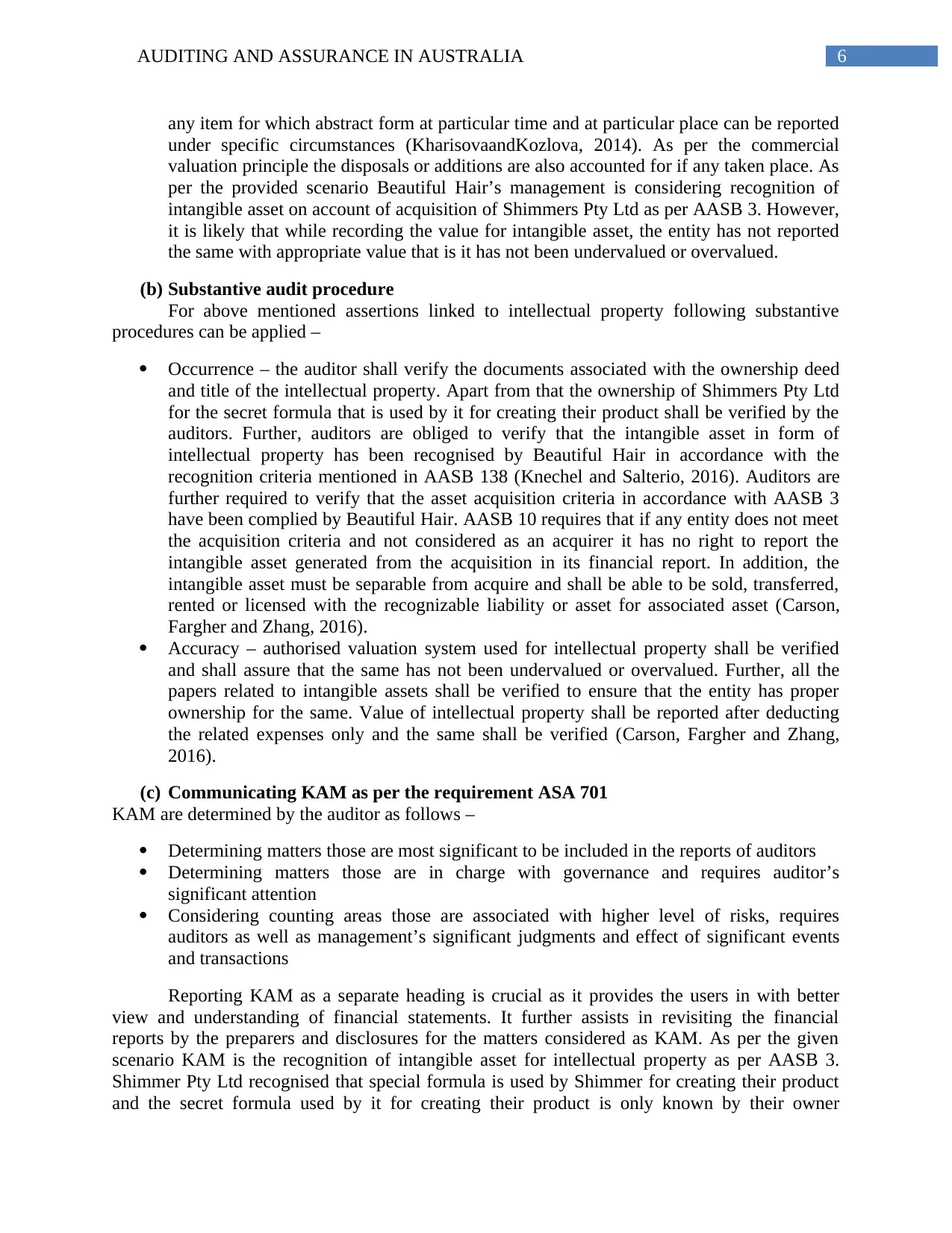
6AUDITING AND ASSURANCE IN AUSTRALIA
any item for which abstract form at particular time and at particular place can be reported
under specific circumstances (KharisovaandKozlova, 2014). As per the commercial
valuation principle the disposals or additions are also accounted for if any taken place. As
per the provided scenario Beautiful Hair’s management is considering recognition of
intangible asset on account of acquisition of Shimmers Pty Ltd as per AASB 3. However,
it is likely that while recording the value for intangible asset, the entity has not reported
the same with appropriate value that is it has not been undervalued or overvalued.
(b) Substantive audit procedure
For above mentioned assertions linked to intellectual property following substantive
procedures can be applied –
Occurrence – the auditor shall verify the documents associated with the ownership deed
and title of the intellectual property. Apart from that the ownership of Shimmers Pty Ltd
for the secret formula that is used by it for creating their product shall be verified by the
auditors. Further, auditors are obliged to verify that the intangible asset in form of
intellectual property has been recognised by Beautiful Hair in accordance with the
recognition criteria mentioned in AASB 138 (Knechel and Salterio, 2016). Auditors are
further required to verify that the asset acquisition criteria in accordance with AASB 3
have been complied by Beautiful Hair. AASB 10 requires that if any entity does not meet
the acquisition criteria and not considered as an acquirer it has no right to report the
intangible asset generated from the acquisition in its financial report. In addition, the
intangible asset must be separable from acquire and shall be able to be sold, transferred,
rented or licensed with the recognizable liability or asset for associated asset (Carson,
Fargher and Zhang, 2016).
Accuracy – authorised valuation system used for intellectual property shall be verified
and shall assure that the same has not been undervalued or overvalued. Further, all the
papers related to intangible assets shall be verified to ensure that the entity has proper
ownership for the same. Value of intellectual property shall be reported after deducting
the related expenses only and the same shall be verified (Carson, Fargher and Zhang,
2016).
(c) Communicating KAM as per the requirement ASA 701
KAM are determined by the auditor as follows –
Determining matters those are most significant to be included in the reports of auditors
Determining matters those are in charge with governance and requires auditor’s
significant attention
Considering counting areas those are associated with higher level of risks, requires
auditors as well as management’s significant judgments and effect of significant events
and transactions
Reporting KAM as a separate heading is crucial as it provides the users in with better
view and understanding of financial statements. It further assists in revisiting the financial
reports by the preparers and disclosures for the matters considered as KAM. As per the given
scenario KAM is the recognition of intangible asset for intellectual property as per AASB 3.
Shimmer Pty Ltd recognised that special formula is used by Shimmer for creating their product
and the secret formula used by it for creating their product is only known by their owner
any item for which abstract form at particular time and at particular place can be reported
under specific circumstances (KharisovaandKozlova, 2014). As per the commercial
valuation principle the disposals or additions are also accounted for if any taken place. As
per the provided scenario Beautiful Hair’s management is considering recognition of
intangible asset on account of acquisition of Shimmers Pty Ltd as per AASB 3. However,
it is likely that while recording the value for intangible asset, the entity has not reported
the same with appropriate value that is it has not been undervalued or overvalued.
(b) Substantive audit procedure
For above mentioned assertions linked to intellectual property following substantive
procedures can be applied –
Occurrence – the auditor shall verify the documents associated with the ownership deed
and title of the intellectual property. Apart from that the ownership of Shimmers Pty Ltd
for the secret formula that is used by it for creating their product shall be verified by the
auditors. Further, auditors are obliged to verify that the intangible asset in form of
intellectual property has been recognised by Beautiful Hair in accordance with the
recognition criteria mentioned in AASB 138 (Knechel and Salterio, 2016). Auditors are
further required to verify that the asset acquisition criteria in accordance with AASB 3
have been complied by Beautiful Hair. AASB 10 requires that if any entity does not meet
the acquisition criteria and not considered as an acquirer it has no right to report the
intangible asset generated from the acquisition in its financial report. In addition, the
intangible asset must be separable from acquire and shall be able to be sold, transferred,
rented or licensed with the recognizable liability or asset for associated asset (Carson,
Fargher and Zhang, 2016).
Accuracy – authorised valuation system used for intellectual property shall be verified
and shall assure that the same has not been undervalued or overvalued. Further, all the
papers related to intangible assets shall be verified to ensure that the entity has proper
ownership for the same. Value of intellectual property shall be reported after deducting
the related expenses only and the same shall be verified (Carson, Fargher and Zhang,
2016).
(c) Communicating KAM as per the requirement ASA 701
KAM are determined by the auditor as follows –
Determining matters those are most significant to be included in the reports of auditors
Determining matters those are in charge with governance and requires auditor’s
significant attention
Considering counting areas those are associated with higher level of risks, requires
auditors as well as management’s significant judgments and effect of significant events
and transactions
Reporting KAM as a separate heading is crucial as it provides the users in with better
view and understanding of financial statements. It further assists in revisiting the financial
reports by the preparers and disclosures for the matters considered as KAM. As per the given
scenario KAM is the recognition of intangible asset for intellectual property as per AASB 3.
Shimmer Pty Ltd recognised that special formula is used by Shimmer for creating their product
and the secret formula used by it for creating their product is only known by their owner
Paraphrase This Document
Need a fresh take? Get an instant paraphrase of this document with our AI Paraphraser
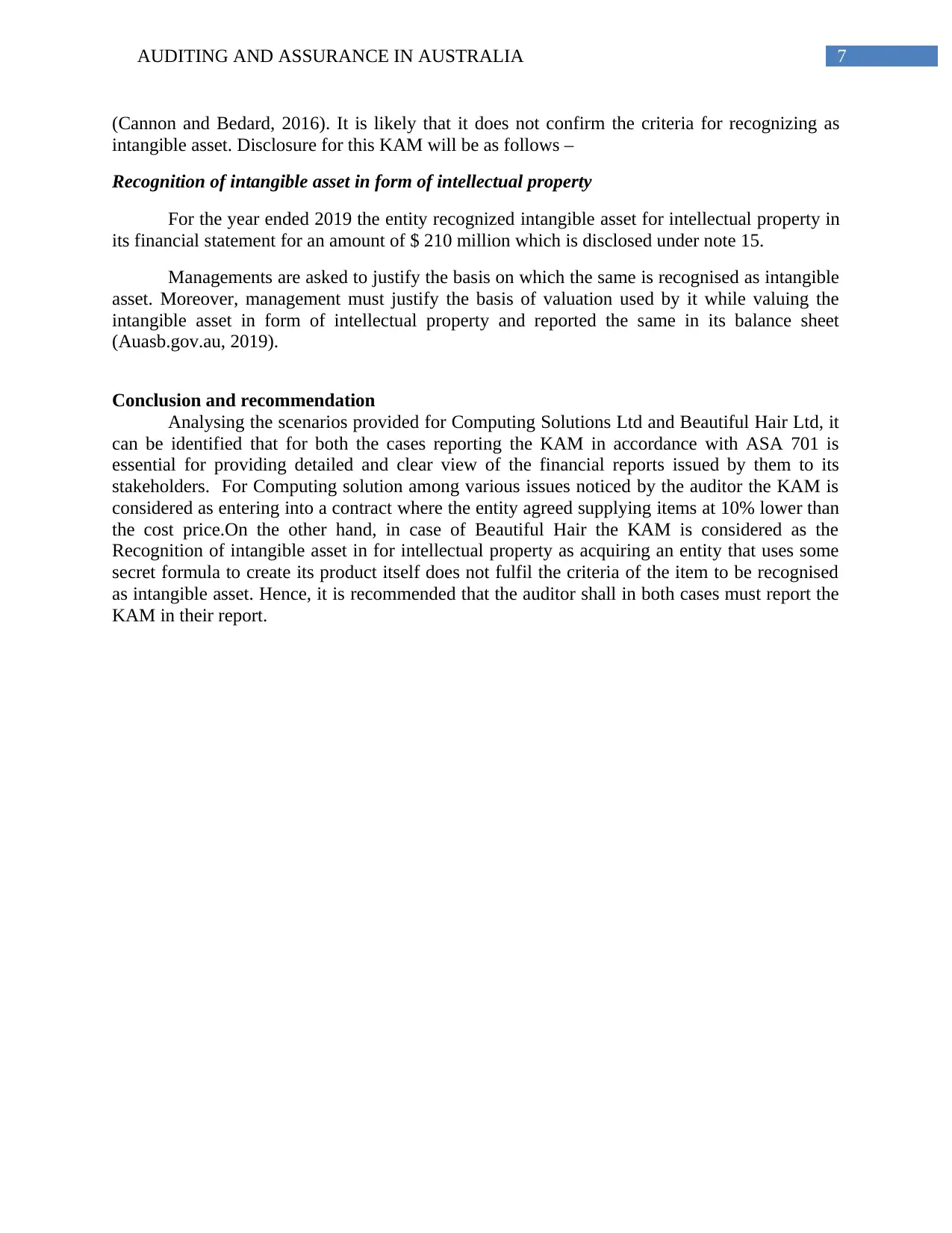
7AUDITING AND ASSURANCE IN AUSTRALIA
(Cannon and Bedard, 2016). It is likely that it does not confirm the criteria for recognizing as
intangible asset. Disclosure for this KAM will be as follows –
Recognition of intangible asset in form of intellectual property
For the year ended 2019 the entity recognized intangible asset for intellectual property in
its financial statement for an amount of $ 210 million which is disclosed under note 15.
Managements are asked to justify the basis on which the same is recognised as intangible
asset. Moreover, management must justify the basis of valuation used by it while valuing the
intangible asset in form of intellectual property and reported the same in its balance sheet
(Auasb.gov.au, 2019).
Conclusion and recommendation
Analysing the scenarios provided for Computing Solutions Ltd and Beautiful Hair Ltd, it
can be identified that for both the cases reporting the KAM in accordance with ASA 701 is
essential for providing detailed and clear view of the financial reports issued by them to its
stakeholders. For Computing solution among various issues noticed by the auditor the KAM is
considered as entering into a contract where the entity agreed supplying items at 10% lower than
the cost price.On the other hand, in case of Beautiful Hair the KAM is considered as the
Recognition of intangible asset in for intellectual property as acquiring an entity that uses some
secret formula to create its product itself does not fulfil the criteria of the item to be recognised
as intangible asset. Hence, it is recommended that the auditor shall in both cases must report the
KAM in their report.
(Cannon and Bedard, 2016). It is likely that it does not confirm the criteria for recognizing as
intangible asset. Disclosure for this KAM will be as follows –
Recognition of intangible asset in form of intellectual property
For the year ended 2019 the entity recognized intangible asset for intellectual property in
its financial statement for an amount of $ 210 million which is disclosed under note 15.
Managements are asked to justify the basis on which the same is recognised as intangible
asset. Moreover, management must justify the basis of valuation used by it while valuing the
intangible asset in form of intellectual property and reported the same in its balance sheet
(Auasb.gov.au, 2019).
Conclusion and recommendation
Analysing the scenarios provided for Computing Solutions Ltd and Beautiful Hair Ltd, it
can be identified that for both the cases reporting the KAM in accordance with ASA 701 is
essential for providing detailed and clear view of the financial reports issued by them to its
stakeholders. For Computing solution among various issues noticed by the auditor the KAM is
considered as entering into a contract where the entity agreed supplying items at 10% lower than
the cost price.On the other hand, in case of Beautiful Hair the KAM is considered as the
Recognition of intangible asset in for intellectual property as acquiring an entity that uses some
secret formula to create its product itself does not fulfil the criteria of the item to be recognised
as intangible asset. Hence, it is recommended that the auditor shall in both cases must report the
KAM in their report.
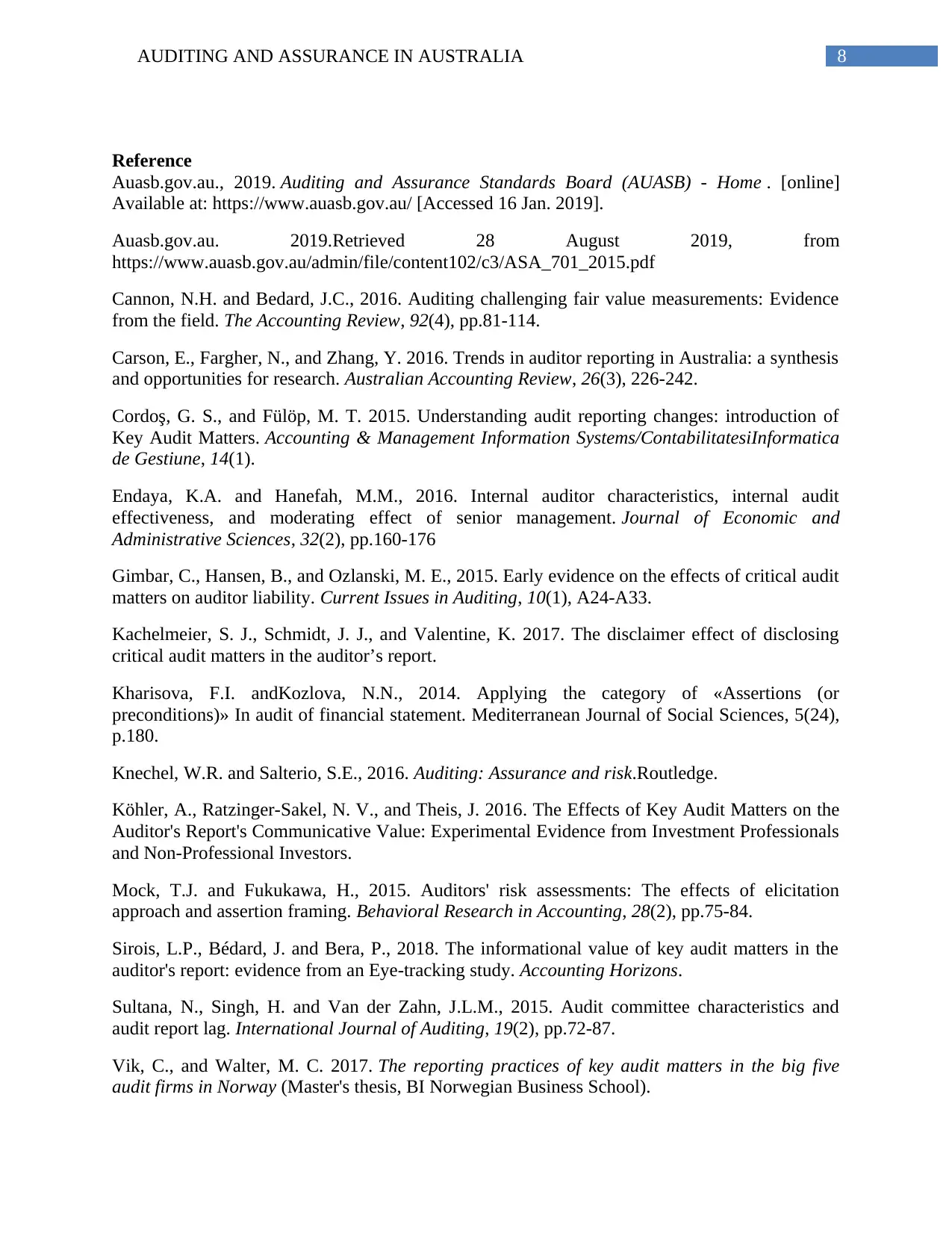
8AUDITING AND ASSURANCE IN AUSTRALIA
Reference
Auasb.gov.au., 2019. Auditing and Assurance Standards Board (AUASB) - Home . [online]
Available at: https://www.auasb.gov.au/ [Accessed 16 Jan. 2019].
Auasb.gov.au. 2019.Retrieved 28 August 2019, from
https://www.auasb.gov.au/admin/file/content102/c3/ASA_701_2015.pdf
Cannon, N.H. and Bedard, J.C., 2016. Auditing challenging fair value measurements: Evidence
from the field. The Accounting Review, 92(4), pp.81-114.
Carson, E., Fargher, N., and Zhang, Y. 2016. Trends in auditor reporting in Australia: a synthesis
and opportunities for research. Australian Accounting Review, 26(3), 226-242.
Cordoş, G. S., and Fülöp, M. T. 2015. Understanding audit reporting changes: introduction of
Key Audit Matters. Accounting & Management Information Systems/ContabilitatesiInformatica
de Gestiune, 14(1).
Endaya, K.A. and Hanefah, M.M., 2016. Internal auditor characteristics, internal audit
effectiveness, and moderating effect of senior management. Journal of Economic and
Administrative Sciences, 32(2), pp.160-176
Gimbar, C., Hansen, B., and Ozlanski, M. E., 2015. Early evidence on the effects of critical audit
matters on auditor liability. Current Issues in Auditing, 10(1), A24-A33.
Kachelmeier, S. J., Schmidt, J. J., and Valentine, K. 2017. The disclaimer effect of disclosing
critical audit matters in the auditor’s report.
Kharisova, F.I. andKozlova, N.N., 2014. Applying the category of «Assertions (or
preconditions)» In audit of financial statement. Mediterranean Journal of Social Sciences, 5(24),
p.180.
Knechel, W.R. and Salterio, S.E., 2016. Auditing: Assurance and risk.Routledge.
Köhler, A., Ratzinger-Sakel, N. V., and Theis, J. 2016. The Effects of Key Audit Matters on the
Auditor's Report's Communicative Value: Experimental Evidence from Investment Professionals
and Non-Professional Investors.
Mock, T.J. and Fukukawa, H., 2015. Auditors' risk assessments: The effects of elicitation
approach and assertion framing. Behavioral Research in Accounting, 28(2), pp.75-84.
Sirois, L.P., Bédard, J. and Bera, P., 2018. The informational value of key audit matters in the
auditor's report: evidence from an Eye-tracking study. Accounting Horizons.
Sultana, N., Singh, H. and Van der Zahn, J.L.M., 2015. Audit committee characteristics and
audit report lag. International Journal of Auditing, 19(2), pp.72-87.
Vik, C., and Walter, M. C. 2017. The reporting practices of key audit matters in the big five
audit firms in Norway (Master's thesis, BI Norwegian Business School).
Reference
Auasb.gov.au., 2019. Auditing and Assurance Standards Board (AUASB) - Home . [online]
Available at: https://www.auasb.gov.au/ [Accessed 16 Jan. 2019].
Auasb.gov.au. 2019.Retrieved 28 August 2019, from
https://www.auasb.gov.au/admin/file/content102/c3/ASA_701_2015.pdf
Cannon, N.H. and Bedard, J.C., 2016. Auditing challenging fair value measurements: Evidence
from the field. The Accounting Review, 92(4), pp.81-114.
Carson, E., Fargher, N., and Zhang, Y. 2016. Trends in auditor reporting in Australia: a synthesis
and opportunities for research. Australian Accounting Review, 26(3), 226-242.
Cordoş, G. S., and Fülöp, M. T. 2015. Understanding audit reporting changes: introduction of
Key Audit Matters. Accounting & Management Information Systems/ContabilitatesiInformatica
de Gestiune, 14(1).
Endaya, K.A. and Hanefah, M.M., 2016. Internal auditor characteristics, internal audit
effectiveness, and moderating effect of senior management. Journal of Economic and
Administrative Sciences, 32(2), pp.160-176
Gimbar, C., Hansen, B., and Ozlanski, M. E., 2015. Early evidence on the effects of critical audit
matters on auditor liability. Current Issues in Auditing, 10(1), A24-A33.
Kachelmeier, S. J., Schmidt, J. J., and Valentine, K. 2017. The disclaimer effect of disclosing
critical audit matters in the auditor’s report.
Kharisova, F.I. andKozlova, N.N., 2014. Applying the category of «Assertions (or
preconditions)» In audit of financial statement. Mediterranean Journal of Social Sciences, 5(24),
p.180.
Knechel, W.R. and Salterio, S.E., 2016. Auditing: Assurance and risk.Routledge.
Köhler, A., Ratzinger-Sakel, N. V., and Theis, J. 2016. The Effects of Key Audit Matters on the
Auditor's Report's Communicative Value: Experimental Evidence from Investment Professionals
and Non-Professional Investors.
Mock, T.J. and Fukukawa, H., 2015. Auditors' risk assessments: The effects of elicitation
approach and assertion framing. Behavioral Research in Accounting, 28(2), pp.75-84.
Sirois, L.P., Bédard, J. and Bera, P., 2018. The informational value of key audit matters in the
auditor's report: evidence from an Eye-tracking study. Accounting Horizons.
Sultana, N., Singh, H. and Van der Zahn, J.L.M., 2015. Audit committee characteristics and
audit report lag. International Journal of Auditing, 19(2), pp.72-87.
Vik, C., and Walter, M. C. 2017. The reporting practices of key audit matters in the big five
audit firms in Norway (Master's thesis, BI Norwegian Business School).
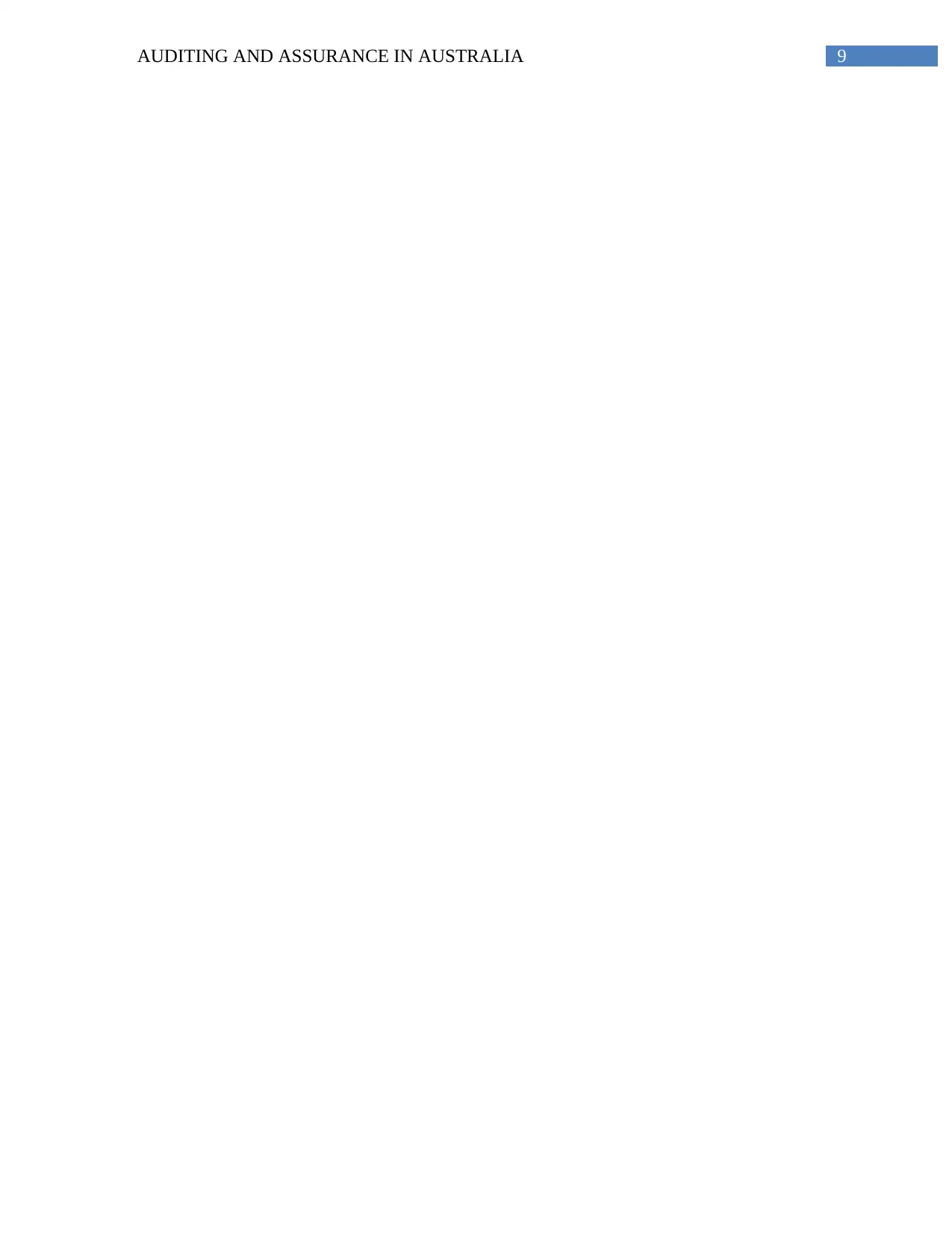
9AUDITING AND ASSURANCE IN AUSTRALIA
1 out of 10
Related Documents
Your All-in-One AI-Powered Toolkit for Academic Success.
+13062052269
info@desklib.com
Available 24*7 on WhatsApp / Email
![[object Object]](/_next/static/media/star-bottom.7253800d.svg)
Unlock your academic potential
© 2024 | Zucol Services PVT LTD | All rights reserved.





